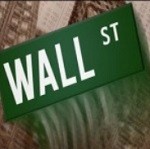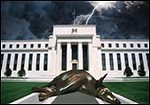-
Recent Posts
- Trump’s “Big Beautiful Bill” Is a Grotesque Giveaway to Fossil Fuel Billionaires While Adding $3.3 Trillion to Nation’s Debt
- Senator Chris Murphy Charges that Trump “Has Opened a Channel for Bribery”
- Congressman Casten: Trump’s Assault on the Rule of Law Is Causing Capital Flight Out of U.S. by Foreign Investors
- Trump’s Approval Rating Drops to 80-Year Low; IMF Says U.S. Tariffs Now Exceed the Highs During the Great Depression
- Nasdaq Has Lost More than 3,000 Points Since Trump’s First Full Day in Office in 2025; the Pain Has Barely Begun
- The Bond Crisis Last Week Was a Global No-Confidence Vote in U. S. President Donald Trump
- Trump’s Tariff Plan Guts $5 Trillion in Stock Value in Two Days; Senator Warren Calls for Emergency Action Before Markets Open on Monday
- Trump’s Attacks on Big Law, Universities, and the Media Have a Common Goal: Silence Dissent Against Authoritarian Rule
- Trump Administration Gives All Clear to Laundering Money through Shell Companies and Bribing Foreign Officials
- Four Megabanks on Wall Street Hold $3.2 Trillion in Uninsured Deposits – Which May Explain Senator Schumer’s Pivot to the GOP to Stop a Government Shutdown
- Here’s What Came Crashing Down Yesterday for Trump’s “Genius” Guy, Elon Musk: Tesla Stock, Access to Twitter (X), His Years of Secret Calls with Putin
- After Banning the Associated Press, Trump Is Now Targeting Specific Journalists That He Wants to See Fired
- Closely Watched Atlanta Fed Model Predicts Negative U.S. Growth in First Quarter
- Trump’s Gangster Diplomacy Makes Front Page Headlines Around the Globe
- Who Benefits Alongside Elon Musk If He Succeeds in Killing the CFPB: the Megabanks on Wall Street that Underwrite His Tesla Stock Offerings
- In Trump 1.0, the State Department Used Taxpayer Money to Publish a Book Elevating Elon Musk to a Superhero; It Was Funded by USAID, the Agency Musk Wants to Quickly Shut Down
- News Host Joy Reid Raises Threat of Trump Selling U.S. to Putin; Ten Days Later Her Show Is Cancelled
- Elon Musk’s DOGE Appears to Be Violating a Court Order; It Has Taken Down Hundreds of YouTube Videos that Educate Americans on How to Avoid Being Swindled
- Barron’s Releases Audio of Jamie Dimon Cursing Out His Workers at a Town Hall, as Dimon Plans to Dump Another One Million JPM Shares
- There’s One Federal Investigative Agency that Neither Trump nor Elon Musk Can Touch: It Just Opened an Investigation into DOGE
- Elon Musk’s Companies Were Under Investigation by Five Inspectors General When the Trump Administration Fired Them and Made Musk the Investigator
- Donald Trump Gives the Greenlight to Goldman Sachs and JPMorgan Chase to Return to Bribing Foreign Officials
- After Tech Geeks Built a Back Door to Loot Billions from FTX, Republicans Refuse to Investigate What Elon Musk’s Tech-Squad Did Inside the U.S. Treasury’s Payment System
- Former Prosecutor, Now U.S. Senator, Informs Tesla That CEO Musk May Be Violating Federal Law and to “Preserve All Records”
- Trump’s Hedge Fund Guy Is Now Overseeing the U.S. Treasury, IRS, OCC, U.S. Mint, FinCEN, F-SOC, and the Consumer Financial Protection Bureau
- As Elon Musk Begins Shutting Down Payments to Federal Contractors, a Strange Money Trail Emerges to His Operatives Inside the U.S. Treasury’s Payment System
- JPMorgan Chase Charged by Yet Another Internal Whistleblower with Cooking the Books
- We Asked Google’s AI Search Model, Gemini, Questions About the Fed and Wall Street Megabanks: It Got the Answers Dead Wrong
- With Trump and Melania’s Crypto Coins Likely to Raise Legal Challenges, Why Didn’t Trump Fire the SEC’s Inspector General in His Purge of IGs?
- Fossil Fuel Industry Could End Up Paying Tens of Billions for LA Wildfires and Deceiving the Public on Climate Change for Decades
- It’s Being Called the Biggest Grift by a President in U.S. History: Trump and First Lady Launch their Own Crypto Coins
- Trump Plans to Install a Fracking CEO to Head the Energy Department and Declare a National Emergency on Energy to Gain Vast Powers
- Fossil Fuel Money Played a Role in the Los Angeles Fires and the Push to Install Pete Hegseth as Secretary of Defense
- When It Comes to Wealth Retention in Retirement, Concrete May Be the New Gold
- Wall Street Watchdog Warns “Clock Is Ticking on a Coming Catastrophic Financial Crash”
- Wall Street Is Sending the Same Message to Americans on Fossil Fuel Financing that It Sent on Cigarettes: Drop Dead
- In a Six-Week Span, this Dark Pool with a Curious Past Traded 3.7 Billion Shares
- Wall Street’s Lobby Firm Hired Eugene Scalia of Gibson Dunn to Sue the Fed for Jamie Dimon
- Postmaster General Louis DeJoy Made $561,051 in Compensation in 2024, as Mail Costs Spiked and Delivery Deteriorated
- Fed Chair Jay Powell Sends a Bold Message to Trump and Tanks the Dow by 1123 Points
- The Head of Fixed Income at T. Rowe Price Makes the Scary Case for the 10-Year Treasury to Spike to 6 Percent
- $663 Billion in Cash Assets Have Gone Poof at the Largest U.S. Banks
- Donald Trump to Ring Bell at New York Stock Exchange Today as Hit List Posters Appear in Manhattan Targeting Wall Street CEOs
- Trump Has a Slush Fund to Prop Up the Dollar – Will He Use It to Prop Up Bitcoin Instead?
- A CEO Assassination; a Billionaire Heiress/NYPD Commissioner; a Secret Wall Street Spy Center – Here’s How They’re Connected
- Despite More than 1600 Tech Scientists Signing a Letter Calling Crypto a Sham, Trump Names a Crypto Cheerleader for SEC Chair
- The Fed Rings a Warning Bell: Hedge Funds and Life Insurers Are Reporting Historic Leverage
- Trump’s Nominee for FBI Director, Kash Patel, Has Businesses Financially Intertwined with Trump
- Donald Trump Is at Risk of Getting Named in a Fossil Fuels Conspiracy Lawsuit
- Trump Is Having Difficulty Getting a Lawyer to Accept the Nomination for SEC Chair: Here’s Why
Search Results for: JPMorgan
Goldman Sachs and Morgan Stanley Have Mysteriously Disappeared from this Week’s Senate and House Banking Hearings

By Pam Martens and Russ Martens: September 20, 2022 ~ There are eight Global Systemically Important Banks (G-SIBS) in the U.S. They are: JPMorgan Chase, Citigroup, Bank of America, Goldman Sachs, Bank of New York Mellon, Morgan Stanley, State Street and Wells Fargo. These are the banks that pose the greatest risk to the stability of the U.S. financial system and are monitored under the Federal Reserve’s stress tests. Five of those eight banks pose the greatest risk to financial stability because together they hold $200.18 trillion (yes trillion) in notional derivatives (face amount) or 86 percent of all derivatives held by all of the nation’s banks, according to the Office of the Comptroller of the Currency – the federal regulator of national banks. Those banks are: JPMorgan Chase, Citigroup, Goldman Sachs, Morgan Stanley, and Bank of America. In any Senate Banking or House Financial Services Committee hearing that is going … Continue reading
The Market Is Freaking Out Over the Potential for a Perfect Storm: Fed Tightening, Shaky Mega Banks, and a Sharp Decline in Household Wealth

By Pam Martens and Russ Martens: September 14, 2022 ~ The Dow Jones Industrial Average dropped 1,276 points yesterday for a decline of 3.94 percent. The Dow’s losses were outpaced by the tech-heavy Nasdaq, which gave up 632.8 points for a drop of 5.16 percent. The sharp selloff was triggered by the 8:30 a.m. report yesterday morning, an hour before the opening bell of the New York Stock Exchange, that inflation had come in hotter than expected in August. Wall Street had been looking for a 0.1 percent decline in the Consumer Price Index (CPI). Instead, the August reading showed an increase of 0.1 percent. The year-over-year rate slowed to 8.3 percent from 8.5 percent in July. The Fed is set to meet next Tuesday and Wednesday and with the CPI number coming in hotter than anticipated, there is now talk of the Fed slamming on the brakes more than anticipated, … Continue reading
Trump Administration Prosecutor Charges in New Book that Justice Department Was Corrupted by Trump and Attorney General William Barr

By Pam Martens and Russ Martens: September 13, 2022 ~ Two new nonfiction books are being released today. Bestselling author and anthropologist Sarah Kendzior’s book, They Knew, describes Donald Trump as a “transnational career criminal.” The book from the former top federal prosecutor in the Southern District of New York under the Trump Justice Department, Geoffrey Berman, a Republican, reinforces Kendzior’s thesis with the revelation that Trump’s Justice Department was weaponized “to aid the President’s friends and punish his enemies,” both foreign and domestic. One of the most outrageous demands from the Justice Department, writes Berman, was “pressure to pursue baseless criminal charges against John Kerry, who had served in the Obama administration as secretary of state.” Berman writes the following in Holding the Line: Inside the Nation’s Preeminent US Attorney’s Office and Its Battle with the Trump Justice Department: “Throughout my tenure as U.S. attorney, Trump’s Justice Department kept demanding that I use my office … Continue reading
Nonfiction Book Explains the Oligarchs’ Plot to Break Up the U.S. – To Make It Easier to Sell Off Its Parts

By Pam Martens and Russ Martens: September 12, 2022 ~ Sarah Kendzior turned 44 on September 1. She has already had two bestselling books. She holds a Ph.D. in anthropology from Washington University with a focus on authoritarian regimes. We mention this as background because Kendzior’s latest book, They Knew: How a Culture of Conspiracy Keeps America Complacent, to be released tomorrow by Flatiron Books, needs to be read as the work of a serious scholar. Six years ago Kendzior correctly predicted in numerous articles what the rise of Trumpism would bring to the United States. On August 3, 2016, three months before the presidential election, Kendzior wrote the following for Foreign Policy under the headline: “Welcome to Donald Trump’s America”: “For over a year, pundits — especially Republicans who have a stake in legitimizing their party’s abject surrender — have been claiming that Trump will eventually pivot from his extremist positions. They … Continue reading
After Funneling Trillions of Dollars in Repo Loans to Serial Bank Offenders, Lorie Logan Gets a $440,000 Job Running the Dallas Fed

By Pam Martens and Russ Martens: September 8, 2022 ~ Bailing out the Wall Street megabanks that are serially fined and hit with felony counts appears to be catching on as a major career advancement strategy at the New York Fed. On August 22, Lorie Logan began her big promotion as President of the Dallas Fed, a position that paid $440,700 at the end of 2020. That’s $40,700 more than the salary of the President of the United States. Prior to joining the Dallas Fed, Logan was the Manager of the System Open Market Account (SOMA) at the New York Fed, effectively the Fed’s trading floor. As part of her job, Logan oversaw the trillions of dollars that were electronically created at the New York Fed to bail out Wall Street trading houses in the fall of 2019 and through the middle of 2020. (See our related report The Fed Appears … Continue reading
The Fed Appears to Have Violated the Dodd-Frank Act in the Second Quarter of 2020, Giving $455 Billion in Loans to Citigroup

By Pam Martens and Russ Martens: September 8, 2022 ~ The Fed would appear to have violated both the spirit and the letter of the Dodd-Frank financial reform legislation in the second quarter of 2020, according to new repo loan data released by the New York Fed for the second quarter of 2020. The data shows that Citigroup received 96 percent of all repo loans made by the Fed between June 24, 2020 and June 30, 2020. Citigroup also dwarfed all other borrowers in the Fed’s repo loan program during the full second quarter of 2020. Citigroup borrowed a cumulative total of $454,751,000,000 from the Fed between April 1 and June 30, 2020. Of the 24 firms that borrowed during the second quarter of 2020 from the Fed’s repo loan program, Citigroup’s share amounted to more than the combined total of 19 firms. (See charts above and below.) Congress and the … Continue reading
President Biden, a New Book and a Poll Say American Democracy Is Under Grave Threat

By Pam Martens: September 7, 2022 On Thursday evening, September 1, President Joe Biden addressed the nation from Philadelphia, the second location of the U.S. Capitol in its early years. During his remarks, Biden spoke these words: “Too much of what’s happening in our country today is not normal. Donald Trump and the MAGA Republicans represent an extremism that threatens the very foundations of our republic. “Now, I want to be very clear — very clear up front: Not every Republican, not even the majority of Republicans, are MAGA Republicans. Not every Republican embraces their extreme ideology. I know because I’ve been able to work with these mainstream Republicans. “But there is no question that the Republican Party today is dominated, driven, and intimidated by Donald Trump and the MAGA Republicans, and that is a threat to this country.” The two most important words in this excerpt from Biden’s remarks are the … Continue reading
The Fed Issues a Warning to Member Banks about Engaging in Crypto Activities

By Pam Martens and Russ Martens: August 17, 2022 ~ After crypto has blighted trust in the financial landscape of the United States and left tens of thousands of Americans as victims of theft, or locked out of access to their money, the Federal Reserve has finally found the courage to take on the loud-mouthed crypto hawkers and issue a warning. The Fed sent a letter yesterday to supervisory staff at its 12 regional Federal Reserve banks and to all Fed member banks. The letter started out with a curious sentence (potentially crafted to assuage the loud-mouthed crypto hawkers which include a significant number of right-wing members of Congress on the Senate Banking and House Financial Services Committees which oversee the Fed). The sentence read: “The emerging crypto-asset sector presents potential opportunities to banking organizations, their customers, and the overall financial system…” (Italics added.) The word “opportunities” typically suggests that something of … Continue reading
During Both Obama and Trump Administrations, the Justice Department Has Looked the Other Way at Crimes by the Powerful

By Pam Martens and Russ Martens: August 15, 2022 ~ Last Thursday evening, Justice Department Attorney General, Merrick Garland, held a brief press conference to announce that he had asked a federal court to unseal the search warrant and inventory receipts filed in connection with the FBI’s search of Donald Trump’s Palm Beach oceanfront home and beach resort, Mar-a- Lago. As part of his statement to the press, Garland said this: “Faithful adherence to the rule of law is the bedrock principle of the Justice Department and of our democracy. Upholding the rule of law means applying the rule of law evenly, without fear or favor.” Unfortunately, the vast majority of Americans believe there is one set of laws for the rich and powerful and another set of laws for average Americans. According to a Gallup poll released on July 5, only 14 percent of Americans had “a great deal” or … Continue reading
China Moves to Delist Five State-Owned Companies from the New York Stock Exchange

By Pam Martens and Russ Martens: August 15, 2022 ~ This past Friday, five state-owned companies in China announced that they would apply this month to delist their shares from the New York Stock Exchange. The companies plan to continue trading in Hong Kong and mainland China. The companies include the large oil company Sinopec; China Life Insurance; Aluminum Corporation of China; PetroChina; and Sinopec Shanghai Petrochemical Company. It is highly likely (and long overdue) that more Chinese share delistings on U.S. exchanges will follow. For the past two decades, China has been stonewalling U.S. regulators over access to the work papers of auditors of publicly traded companies that are based in China but listed on U.S. stock exchanges. China takes the position that these audit work papers hold state secrets and it prohibits audit firms from releasing the documents directly to U.S. regulators, effectively flouting U.S. accounting law. This untenable situation … Continue reading

